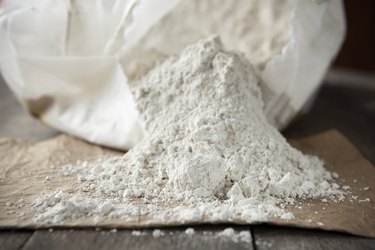You might mistake diatomaceous earth for baby talc, it's so soft. But it's so much more useful around the house. Diatomaceous earth (also known as DE or diatomite) is an almost-white, powdery substance that is a nontoxic insecticide made from the fossilized remains of marine phytoplankton, a group of single-celled organisms that float on the ocean surface. Just avoid breathing it in as you are dusting it around since it can cause nasal irritation.

Video of the Day
What Is Diatomaceous Earth?
Diatomaceous earth may sound like one of those products sold in big bright ads or as "sponsored" posts on social media. "DE for bed bugs! DE for cockroaches! DE for fleas since diatomaceous earth is safe for pets!" You wouldn't be alone if you doubt the claims of the product, but, in fact, it is actually a sort of natural miracle.
Video of the Day
Diatomaceous earth is a soft powder made from an easily crumbled sedimentary rock. But it's a lot more interesting than most powders, since the rock is in fact composed of millions of fossils of marine and freshwater organisms, particularly diatoms. Diatoms refer to a special group of tiny ocean-floating organisms, also called phytoplankton.
DE is an effective natural substance for repelling bugs. That's because the diatom skeletons are made of amorphous silica or opal, products that crush up into tiny pieces of glass. The pieces are minuscule, and the powder feels soft like talc. But it attaches readily to the hairy bodies of most insects. Scratchy to them, it gets inside their protective wax layers. When some of the product is absorbed, the bugs lose fluids and die.
Is Diatomaceous Earth Safe for Pets?
Diatomaceous earth is used as an insecticide in the garden to discourage snails, slugs and other crawling pests. Gardeners just sprinkle a little natural DE around their susceptible plants to protect them. DE can also be used indoors against cockroaches, ants, silverfish, crickets, millipedes, centipedes, fleas, carpet beetles and bed bugs.
The best news for pet owners is that natural diatomaceous earth is virtually nontoxic to all mammals. That means that you can eat pure, natural diatomaceous earth, and many people use it as a food supplement. But you have to be careful here, since there are other types of DE (e.g., those used as filtering agents in swimming pools) that are heat-treated and contain additives making them a hazard.
DE is great to keep fleas off pets as well. Unlike chemical products, DE is safe for pets and lasts a long time. Sprinkle it around a pet's bedding and as long as the powder is there, the pet is protected.
Cleaning Up Diatomaceous Earth
One warning about DE: if you are dusting large areas, wear a mask so that you don't inhale it. If you breathe it in, it can irritate the nose and nasal passages. In large amounts, it can cause coughing as well. You aren't likely to want diatomaceous earth in your eyes, either. So be sensible when you dust it around, and keep your pets away until you are done.
So, how to get up DE when you've used too much and it's clean-up time? You can sweep it with a broom or mop it up with a mop. If you've got diatomaceous earth on carpets, a vacuum works well. Some fear that the extremely fine particles in diatomaceous earth powder will burn out vacuum motors, although this hasn't been verified in studies. If your machine is old, weak or you are just worried, solve the problem by renting a shop vac or industrial strength machine for an afternoon.